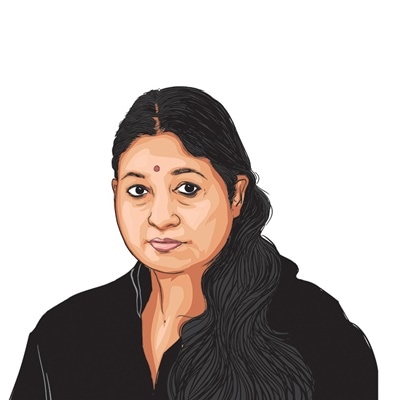Opinion The shaligramas at Ayodhya
Decision to carve Siyaram idol from sacred rocks reaffirms Indic feminism
 Priests and local people offer prayers near the holy stone Shaligram after its arrival from Nepal, at Karsewak Puram in Ayodhya. (PTI)
Priests and local people offer prayers near the holy stone Shaligram after its arrival from Nepal, at Karsewak Puram in Ayodhya. (PTI) Recently, two large boulders, believed to be 60 million years old, were dispatched to Ayodhya. These stones were found along the Gandaki river at a site in Muktinath Valley in Nepal. This region is thought to be part of the erstwhile kingdom of Mithila, ruled by Ram’s father-in-law, Raja Janak. According to the Puranas, these stones, called shaligramas, are considered representations of Lord Vishnu. They are worshipped only by males, as per Vaishnavite beliefs. The Shri Ram Janmabhoomi Teerth Kshetra Trust has chosen these shaligramas as Ram is considered an incarnation of Vishnu. The trust is calling the two shaligramas from Nepal “Dev Shila” (sacred rocks) and most likely, these sacred stones from Mithila will be used to carve out the Ram-Sita idol for the grand temple at Ayodhya.
This trust’s decision is deeply sacred and reinforces the narrative of eternal conjugality of Ram and Sita, and weaves their inseparability into modern Indian statecraft and the emerging socio-cultural order. Interpreting this imagery in juxtaposition to the western tradition of binaries, a la Cartesian dualism, is fallacious.
In Indian textual and oral traditions — for example in the Upanishadic understanding — “Purusha” and “Prakriti”, as creators of the universe, are in cosmic union and divine conjugation. The traditional and laukik (folk) understanding of “Siyaram” is emphatically reinforced by the thoughtfulness behind the choice of the stones. This will allow the philosophical idea of non-binary unity to seep into the public consciousness.
Sita will emerge as a heroine/icon globally. This, in turn, underlines an eastern aesthetic that has the transcendent capacity to approach a blissful experience of harmony. In the Indian tradition, Sita is often seen as the uniting force, the ideal and keeper of dharma and human love. The imagination of Sita is so vast and deep in the Subcontinent, that people and groups have their own Sitas, each a layered idea and figure in her own right. In her Vaidehi avatar, Sita encapsulates being the daughter of Videha and simultaneously escapes the expanse of the body to a higher realm brimming with metaphysical possibilities. Her birth from mother earth shatters all kinds of regional, caste and class narratives. Her decision to choose Ram as her consort and then to participate in his banishment is testimony to their deep spiritual connection.
In Indian folklore, songs, oral traditions and practices, the popular worship of Ram and Sita as one entity has existed from time immemorial. Right from the common greeting to expressing shock/grief and the chanting in the morning of Sitaram/Siyaram — these common words and gestures have a deeper association with the idea that the two figures are a singularity, each incomplete without the other. The decision by the trust is a powerful affirmation of this idea.
Why is it crucial, and historically relevant, to view Ram and Sita together in the public consciousness? From the time of the Ramayana, Ram and Sita preserved in the spiritual consciousness an idea that has the potential to initiate a discourse on the idea of a just world order (Ram Rajya) based on ideas of duty, community service, placing others before the self and sacrifice for supreme order.
The current strategy of carving the deities/idols from the same stone will authenticate their inseparable existence, invoking the highest notion of conjugality, which is otherwise ascribed to Radha-Krishna. Also, “stree shakti”, or women’s full potential being realised, is being foregrounded at Ayodhya. Doing so establishes that since the times of the Smritis, the wife had full rights over her husband’s physical and spiritual property.
The Ramayana, then, provides an icon who can help to restate the essentiality of women in both public and private spaces. This points to the possibility of an Indic alternative to women’s discourses centred around notions that ignore sacredness. The idea of an open dialogic nation with adequate space for its neighbours in its sacred inclusivist statecraft holds the possibility of creating a new paradigm where the cultural icons of two sovereign nations are woven into one.
The sacredness of this new statecraft also has a strong potential in the strategic realm as it brings together two sovereign, neighbouring nations closely tied together through beti-roti (marriage and commensuality) relationships. It’s important to map practices and places and set narratives to invoke an Indian telling of its own sacred statecraft and let the charismatic sacred cultural icons give new civilisational goals to the world.
The writer teaches history at Delhi University






